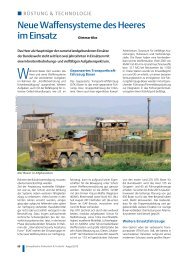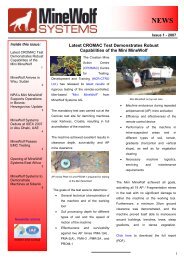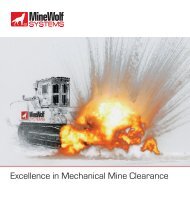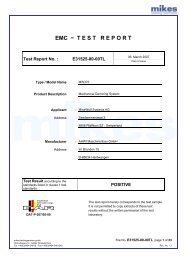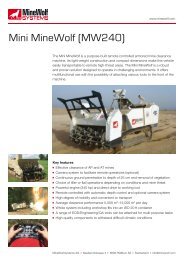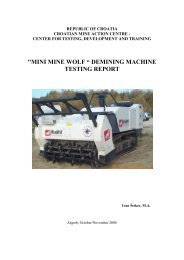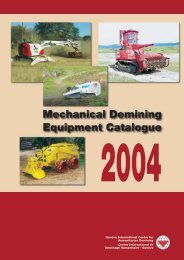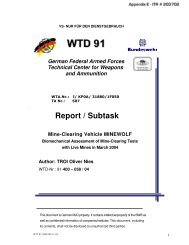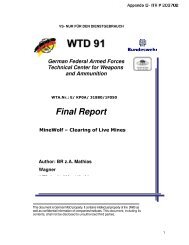Final Report - MineWolf
Final Report - MineWolf
Final Report - MineWolf
Create successful ePaper yourself
Turn your PDF publications into a flip-book with our unique Google optimized e-Paper software.
German Federal Armed Forces<br />
Technical Center for Weapons<br />
and Ammunition<br />
<strong>Final</strong> <strong>Report</strong><br />
!"#$%&'()*)+'$,-"#.)&()/"0$)!"#$1!<br />
Author: BR z.A. Mathias<br />
Wagner<br />
VS- NUR FÜR DEN DIENSTGEBRAUCH<br />
%2345-46)78)9:;38)>;8=?;@;)<br />
This document is German MoD property. It contains intellectual property of the BWB as<br />
well as confidential information of companies/institutes. This document, including its<br />
contents, shall not be disclosed to unauthorized third parties.<br />
1
Defense Technical Order (WTA)<br />
Tel.: 05931/ 43 0<br />
Fax: 05931/ 43 2091<br />
BwFw: 90 2422 –88 (od. App.<br />
Abstract<br />
The mine-clearing system <strong>MineWolf</strong> was tested at WTD 91 Meppen in March 2004 during clearing runs over<br />
live antitank mine types DM 21, TM 57 und TM 62. The purpose of the tests was to assess the effects that<br />
mine detonations in the clearing device area have on the operator and to ascertain the damage caused to<br />
the vehicle.<br />
The effects on the operator by mine detonations of the above types are within the admissible and<br />
acceptable range, provided that the detonations occur on the mine-clearing device.<br />
After each mine detonation the damage on the vehicle was checked and documented and the vehicle was<br />
repaired as required. Necessary repairs, mainly welding work, could be performed on site the same day.<br />
WTD91-310-26/04<br />
BR z.A. Matthias Wagner<br />
Keywords:<br />
Distribution: Seiten: 32<br />
BWB K 61<br />
3EA+7CD`s<br />
WTD 91 - 310<br />
1EA<br />
DirWTD 91 1 EA<br />
BWB Fist 1 EA<br />
WTD 91-AGB-001-01-03<br />
German Federal Armed Forces<br />
Technical Center for Weapons and Ammunition<br />
Schießplatz, 49716 Meppen<br />
Task designation: <strong>MineWolf</strong> – Clearing of Live Mines<br />
Task number:<br />
Task manager:<br />
Business area / section: 300 / 310<br />
<strong>Final</strong> <strong>Report</strong><br />
WTD No.: 91 - 300 - 143/04<br />
Ref.: 90 - 13 - 45<br />
Project designation: Landmine Counter Measures<br />
Project number: 1F050<br />
Requesting authority: BWB<br />
Requesting section : BWB K61 Kronjäger 6352<br />
OrgKz Name Tel.<br />
E/ KP0A/ 31880/ 1F050<br />
BTK OrgKz lfd. WTA-Nummer lfd. Vorh.-Nummer<br />
WTD 91<br />
WTD 91 - 310 Kasper <strong>Report</strong> prepared by: Wagner 2104<br />
OrgKz. Bearbeiter Telefon<br />
2
Content<br />
VS- Nur für den Dienstgebrauch<br />
1.0 Task Description 4<br />
2.0 Summary of Results 4<br />
3.0 Short Description of the Test Item 5<br />
4.0 Schedule and Required Effort 6<br />
5.0 Detailed Description of 7<br />
5.1 Background 7<br />
5.2 Remote Control Tests 7<br />
5.3 Tests with Manned Mine-Clearing Vehicle 8<br />
6.0 Determination of Results and Assessment 9<br />
6.1 Biomechanical Assessment of ATD Measured Values 9<br />
6.2 Blast Pressure Measurements 10<br />
6.3 Mine-Clearing Runs against Live Antitank Mines 10<br />
6.3.1 Test with Flail against Antitank Mine DM 21 (Test 01) 10<br />
6.3.2 Test with Flail against Antitank Mine DM 21 (Test 1) 11<br />
6.3.3 Test with Flail against Antitank Mine TM 57 (Test 2) 11<br />
6.3.4 Test with Tiller against Antitank Mine DM 21 (Test 3) 13<br />
6.3.5 Test with Tiller against Antitank Mine TM 57 (Test 4) 2<br />
6.3.6 Test with Tiller against Antitank Mine TM 62 P3 (Test 02) 4<br />
6.3.7 Test with Flail against Antitank Mine TM 57 (Test 5) 2<br />
6.3.8 Test with Flail against Antitank Mine TM 62 P3 (Test 6) 21<br />
6.3.9 Test with Tiller against Antitank Mine TM 57 (Test 7) 22<br />
6.3.10 Test with Tiller against Antitank Mine TM 62 P3 (Test 8) 24<br />
6.3.11 Test with Tiller against Antitank Mine TM 57 (Test 9) 25<br />
3
VS- Nur für den Dienstgebrauch<br />
6.3.12 Contact Detonation with Antipersonnel Mine DM 31 1<br />
6.3.13 Damage Determination by the Manufacturer<br />
7.0 List of References 3<br />
List of Figures and Pictures 4<br />
4
1 Task Description<br />
The effects of mine detonations on the vehicle during the clearing of live antitank mines<br />
were to be ascertained. This, however, was limited to mine detonations which occur on<br />
the clearing device in front of the vehicle due to the clearing process. The results shall<br />
yield information on<br />
• the mental and physical effects on the operator<br />
• the scope of the resulting damage and the maintenance effort<br />
• the negative effects on an ongoing clearing process<br />
• the planning of an ongoing clearing process<br />
To this end, the vehicle had to be subjected to clearing tests and contact explosions<br />
with live antitank mine types DM 21, TM 62 and TM 57 . Furthermore, a lateral contact<br />
explosion was to be conducted on the vehicle with bounding fragmentation mine DM<br />
31.<br />
2 Summary of Results<br />
VS- Nur für den Dienstgebrauch<br />
The mine-clearing system <strong>MineWolf</strong> with both accessory devices is suitable for<br />
clearing live antitank mines.<br />
The use of the flail device for clearing live antitank mines caused only minor damage<br />
which could be repaired with a limited effort or did not necessitate any repairs at all.<br />
The use of the tiller against live antitank mines resulted in considerably greater damage.<br />
These can only be repaired with a substantially greater effort than those caused with<br />
the flail. The repairs, mainly welding work, could be performed on site the same day.<br />
As a result of the biomechanical evaluation of dummy (ATD) measurements and the<br />
questioning of three operators it can be said that the load on the operator by mine<br />
detonations is within the admissible and acceptable range. This statement applies to the<br />
examined mine types DM 21, TM 62 and TM 57 and only refers to mine detonations<br />
which occur in the area of the clearing device.<br />
5
VS- Nur für den Dienstgebrauch<br />
3 Short Description of the Test Item<br />
The Minewolf is a mine-clearing device which has been developed especially for<br />
humanitarian mine-clearing. It is used for area clearing. The <strong>MineWolf</strong> system consists<br />
of a fragment-proof caterpillar, a protected driver's cab and a mechanically driven<br />
mine-clearing device. Both a flail device and a mine tiller are available. The clearing<br />
process comprises two phases. First the area to be cleared is worked with the flail. This<br />
shall especially initiate or destroy surface-laid antitank mines (ATM) and antipersonnel<br />
mines (APM). In a subsequent second phase with the tiller the remains of the ATM, the<br />
mine fuzes and all APM shall be crushed or initiated. Clearing depths of up to 30 cm in<br />
the soil are achieved with the tiller. According to the UN and the <strong>MineWolf</strong> SOP, a<br />
follow-up search is required to remove incompletely destroyed fuzes and mines.<br />
Fig. 1 <strong>MineWolf</strong> with Flail in Operation<br />
6
Fig. 2: <strong>MineWolf</strong> with Tiller<br />
4. Schedule and Required Effort<br />
Test site: WTD 91 Meppen<br />
VS- Nur für den Dienstgebrauch<br />
Area at Bunker 30000<br />
Schedule: 24 – 25 Feb 04 familiarization and test runs at the "Hufeisenwall"<br />
(horseshoe wall)<br />
01 – 03 Mar 04 unmanned (remote) clearing tests with live<br />
antitank mines<br />
08 – 09 Mar 04 manned clearing tests with live antitank mines<br />
09 Mar 04 contact detonation with bounding mine DM 31<br />
7
5. Detailed Description of Tests<br />
5.1 Background<br />
The clearing tests with live mines were conducted between 01 and 09 March 2004 on the<br />
Meppen premises at bunker 30000. The soil was grown sand covered with grass. The first<br />
four trials were performed via remote control. Then 5 tests with human operators could be<br />
performed.<br />
5.2 Remote Control Tests<br />
On the one hand, the remote control tests serve to ascertain damage that a mine<br />
which is initiated by the clearing process causes to the vehicle. Furthermore, the physical<br />
effects and potential risks for the operator had to be measured by means of an<br />
instrumented test dummy, in order to be able to perform a human-related biomechanical<br />
assessment. This was an indispensable prerequisite for the safety board and the firing<br />
controller to approve manned tests.<br />
To record the measured values an ATD (Anthropometric Test Device = instrumented test<br />
dummy) was placed on the driver's seat, which was fitted with various sensors to measure<br />
the human relevant loads. The pertinent details are contained in the feeder report<br />
"Biomechanical Assessment of Mine-Clearing Tests with Live Mines".<br />
The following measurements and documentations were performed:<br />
• Video recording from outside<br />
• Video recording inside the driver's cab<br />
• Blast pressure measurement inside the driver's cab<br />
• Acceleration measurement inside the driver's cab<br />
• Measurements with the ATD<br />
VS- Nur für den Dienstgebrauch<br />
• Photos of the damage to the mine-clearing devices<br />
A total of 6 remote clearing tests were conducted against live antitank mines. Four of these<br />
tests led to the detonation of the cleared mines and thus to exploitable measuring results.<br />
Two tests each with the two mine-clearing devices<br />
8
(flail and tiller) were conducted against one DM 21 and TM 57 ATM each. In order to<br />
be able to rule out uncontrolled movements of the <strong>MineWolf</strong>, it was secured to a<br />
recovery tank during the tests. The mines to be cleared were laid one by one centrally<br />
in front of the clearing device. After a detonation the vehicle was stopped immediately<br />
and the effects were documented. If required, the clearing device was repaired prior to<br />
the next test run.<br />
5.3 Tests with Manned Mine-Clearing Vehicle<br />
The remote control tests were a necessary prerequisite to perform the manned tests.<br />
The results of the biomechanical assessment and the blast pressure measurement had<br />
to rule out any hazard to the operator when clearing live antitank mines. Since the<br />
results thus obtained only reflected the effect of detonations on the mine-clearing<br />
device, an additional safety measure was required which would prevent the vehicle from<br />
possibly driving over non-initiated mines. This was achieved by securing the <strong>MineWolf</strong><br />
to a recovery tank in such a way that the forward movement of the vehicle was stopped<br />
when the mine had reached the end of the clearing device. The following<br />
measurements and documentations were performed:<br />
• Video recording from outside<br />
• Photos of the damage to the mine-clearing devices<br />
• Questioning of the operators<br />
• Blast pressure measurement<br />
VS- Nur für den Dienstgebrauch<br />
A total of 5 clearing runs with 3 different drivers were performed.<br />
Both mine-clearing devices and 3 different antitank mines (DM 21, TM 57 und TM 62)<br />
were used. The following table provides an overview of the tests conducted:<br />
Run Date Detonation Mine Clearing device Operator<br />
01 01 Mar 04 no DM 21 flail RC<br />
02 03 Mar 04 no TM 62 P3 tiller RC<br />
1 01 Mar 04 yes DM 21 flail RC<br />
2 02 Mar 04 yes TM 57 flail RC<br />
9
VS- Nur für den Dienstgebrauch<br />
02 Mar 04 yes DM 21 tiller RC<br />
4 03 Mar 04 yes TM 57 tiller RC<br />
5 08 Mar 04 yes TM 57 flail human<br />
6 08Mar 04 yes TM62P3 flail human<br />
7 09Mar 04 yes TM57 flail human<br />
8 10 Mar 04 yes TM 62 P3 tiller human<br />
9 10Mar 04 yes TM57 tiller human<br />
6 Determination of Results and Assessment<br />
6.1 Biomechanical Assessment of ATD Measured Values<br />
The measured values of the ATD were evaluated by WTD91 GF 450. As a result of this<br />
evaluation it can be stated there is no intolerable risk of injury for the <strong>MineWolf</strong> operator<br />
itting inside the driver's cab. All human-related criteria which could be evaluated were<br />
fulfilled. The risks of injury are minimal and are far below the valid limits for mine-protected<br />
vehicles. Even in case of repeated consecutive loads no serious consequences have to be<br />
expected. Slight temporary disturbances like headache or muscular pain cannot be<br />
excluded, however.<br />
These statements, however, only apply to mine detonations that occur in the area of the<br />
mine-clearing device. Should there be a mine detonation underneath the vehicle or a track,<br />
completely different effects have to be considered. According to the present state of<br />
knowledge, it cannot be ruled out in that case that the valid limits for mine protection tests<br />
will be exceeded and thus the mine protection criteria will not be fulfilled.<br />
In all areas investigated the loads measured during tiller operation were higher than those<br />
during the flail tests.<br />
10
VS- Nur für den Dienstgebrauch<br />
The biomechanical assessment of the mine-clearing tests are compiled in a separate subtask<br />
report. The details of this summary can be taken from this report.<br />
6.2 Blast Pressure Measurements<br />
The blast pressure measurements were performed by WTD 91 – 630 at the position<br />
"driver's head" in accordance with the "Regulations and Guidelines for the Recording and<br />
Evaluation of Weapons and Detonation Blasts".<br />
The averages peak pressure level was 151.4 dB, the mean time of exposure 68.19 ms<br />
and the averaged peak pressure 0.74 kPa.<br />
The daily permissible number of mine detonations was determined from the measured<br />
values according to the "Threshold level diagram for preventing auditory defects due to<br />
blast loads" for ear protection devices.<br />
Accordingly, the blast pressure load without ear protection is inadmissible.<br />
With headset H – 280 the permissible number of blast pressure loads is 23, with headset<br />
MAX Lite the permissible number of blast pressure loads is 561.<br />
6.3 Mine-Clearing Runs against Live Antitank Mines<br />
6.3.1 Test with Flail against Antitank Mine DM 21 (Test 01)<br />
This test was performed on 01 March 04 at 14:45 hrs with remote control and<br />
instrumented dummy.<br />
The ATM was passed over without any reaction. The vehicle was driven back. The mine<br />
was not visible. It was located with a spade in the loose soil and its surface was carefully<br />
exposed. It was located about 2 m behind its original position. The top was upside. The<br />
garnishing material bonded to the arming cover was missing. Thus it had received<br />
sufficiently strong shocks that should have be led to an initiation.<br />
After 15 minutes it was passed over again without changing its position, again without any<br />
reaction. The mine body was visible in the soil material and was covered with about 2 cm<br />
of soil. This was carefully removed by hand. The flail hits were even stronger than before.<br />
The mine had to be destroyed without any further contact.<br />
The test could not be exploited.<br />
11
VS- Nur für den Dienstgebrauch<br />
6.3.2 Test with Flail against Antitank Mine DM 21 (Test 1)<br />
This test was performed on 01 March 04 at 15:45 hrs with remote control and<br />
instrumented dummy.<br />
The ATM DM 21 detonated on site upon contact with the mine-clearing device. The<br />
vehicle was stopped immediately.<br />
The hit occurred approx. 1 m off the right-hand outer edge.<br />
Damage:<br />
The right-hand rubber mats had been torn off. One link of the mainly affected flail chain<br />
was slightly bent. Clearing could be continued with this damage.<br />
Thus, the clearing result was very good.<br />
Fig. 3: Effects of the Mine Detonation from Test 1<br />
6.3.3 Test with Flail against Antitank Mine TM 57 (Test 2)<br />
This test was performed on 02 March 04 at 10:05 hrs with remote control and<br />
instrumented dummy.<br />
12
VS- Nur für den Dienstgebrauch<br />
The ATM TM 57 detonated on site upon contact with the mine-clearing device.<br />
The vehicle was stopped immediately.<br />
The hit occurred approx. 1 m off the left-hand outer edge.<br />
Damage:<br />
The left-hand rubber mats were lightly torn. Their mounting rails on the left support arm<br />
were less damaged than during the previous test on the right-hand side.<br />
The mount of the mainly affected flail chain was expanded but easy to repair.<br />
Thus, the clearing result was still very good.<br />
Fig. 4: Eroded Flail after Test 2<br />
13
Fig. 5: Expanded Mount after Test 2<br />
6.3.4 Test with Tiller against Antitank Mine DM 21 (Test 3)<br />
This test was performed on 02 March 04 at 11:35 hrs with remote control and<br />
instrumented dummy.<br />
The ATM DM 21 detonated on site upon contact with the mine-clearing device. The vehicle<br />
was stopped immediately.<br />
The hit occurred centrally. Damage:<br />
Two directly affected chisel teeth were worn, 2 others were pushed out to the rear. Three<br />
of the 30 x 130 cross spars of the tiller were bent.<br />
Clearing could have continued but it was decided to perform repairs instead.<br />
Repair effort:<br />
VS- Nur für den Dienstgebrauch<br />
14
Some of the elements were disassembled by 2-4 persons in the afternoon, some parts of<br />
the affected cross spars were detached, new parts welded in and all parts reassembled.<br />
Thus the damage was slightly greater, but acceptable for a cleared ATM.<br />
Thus, the clearing result was still good.<br />
Fig 6: Mine Detonation during Test 3<br />
Fig 7: Damage to the Tiller after Test 3<br />
VS- Nur für den Dienstgebrauch<br />
15
Fig. 8: Repaired Tiller after Test 3<br />
6.3.5 Test with Tiller against Antitank Mine TM 57 (Test 4)<br />
This test was performed on 03 March 04 at 09:55 hrs with remote control and<br />
instrumented dummy.<br />
The ATM TM 57 detonated on site upon contact with the mine-clearing device.<br />
The vehicle was stopped immediately.<br />
The hit occurred approx. 1.1 m off the right-hand side.<br />
Damage:<br />
VS- Nur für den Dienstgebrauch<br />
One chisel had been pushed out to the rear. 3 rubber mats were torn off.<br />
One of the 30 x 130 cross spars was torn apart and strongly deformed. The adjacent spars<br />
were obviously less deformed than during the preceding test.<br />
Clearing could thus be continued.<br />
Thus, the clearing result was still rather good.<br />
16
VS- Nur für den Dienstgebrauch<br />
Fig. 9: Damage to the Tiller after Test 4<br />
Fig. 10: Missing Chisel after Test 4<br />
17
VS- Nur für den Dienstgebrauch<br />
Fig. 11: Damaged Rubber Mats after Test 4<br />
6.3.6 Test with Tiller against Antitank Mine TM 62 P3 (Test 02)<br />
This test was performed on 03 March 04 at 10:55 hrs with remote control and<br />
instrumented dummy.<br />
The ATM TM 62 P3 was passed over without any reaction. <strong>Final</strong>ly, the bottom part of the<br />
green plastic case was ejected approx. 10 m in forward direction. The vehicle was pulled<br />
back.<br />
The mine with the plastic case had been completely milled in its laying position but not<br />
properly cleared.<br />
The light brown plastic case (100 x 100) with the mine fuze and the primer charge form the<br />
mine body lay on top of the soft soil. The fuze cover had been hit twice and was torn in<br />
nearly over its entire circumference. Thus the firing pin was visible. Its two safety pins were<br />
still attached. This suggests that the fuze with the primer charge was still functional. The<br />
possible effect of the mine was clearly reduced by separating the main charge from the<br />
fuze with primer charge. Nevertheless, a functional fuze with primer charge still represents<br />
a similar threat potential as an antipersonnel mine.<br />
The mine fragments and the fuze had to be destroyed. The clearing result was inadequate.<br />
18
Fig 12: Laid ATM prior to Test 02<br />
Fig 13:PiecesoftheATMafterTest02<br />
VS- Nur für den Dienstgebrauch<br />
19
Fig. 14 Mine Fuze after Test 02<br />
VS- Nur für den Dienstgebrauch<br />
6.3.7 Test with Flail against Antitank Mine TM 57 (Test 5)<br />
This test was performed on 08 March 04 at 13:45 hrs with Michael Kelly (company STS)<br />
as an operator.<br />
The ATM TM 57 detonated on site upon contact with the mine-clearing device.<br />
The vehicle was stopped immediately.<br />
The hit occurred approx. 1.1 m off the right-hand side.<br />
Damage:<br />
No particular damage could be recognized.<br />
Repair effort:<br />
Clearing could have been continued but it was decided to perform repairs instead. Five flail<br />
chains were replaced within 30 minutes.<br />
Operator's impressions:<br />
Mr. Kelly perceived the blast pressure and the acceleration in the armored cabin to be by<br />
all means acceptable.<br />
20
The clearing result was very good.<br />
VS- Nur für den Dienstgebrauch<br />
Fig. 15: Effects of the Mine Detonation from Test 5<br />
Fig. 16: Flail Chain Mounts after Test 5<br />
21
Fig. 17: Repaired Flail after Test 5<br />
VS- Nur für den Dienstgebrauch<br />
6.3.8 Test with Flail against Antitank Mine TM 62 P3 (Test 6)<br />
This test was performed on 08 March 04 at 15:05 hrs with Michael Kelly (company STS)<br />
as an operator.<br />
The ATM TM 62 P3 detonated on site upon contact with the mine-clearing device.<br />
The vehicle was stopped immediately.<br />
The hit occurred approx. 0.7 m off the right-hand side.<br />
Damage:<br />
Only minor damage was recognizable, one flail element was missing.<br />
The mine crater in the ground was of normal size, the same as during the other mine<br />
detonations.<br />
Clearing could have been continued with this damage.<br />
Repair effort:<br />
Since the clearing test with the flail were finished, no repair was performed. Instead, the<br />
flail was replaced by the tiller. This was done with the crane of the armored recovery<br />
vehicle in about 40 minutes.<br />
22
VS- Nur für den Dienstgebrauch<br />
Operator's impressions:<br />
Mr. Kelly perceived the blast pressure and the acceleration in the armored cabin to be by<br />
all means acceptable.<br />
The clearing result was very good.<br />
Fig. 18: Effects of the Mine Detonation from Test 6<br />
6.3.9 Test with Tiller against Antitank Mine TM 57 (Test 7)<br />
This test was performed on 09 March 04 at 10:10 hrs with Michael Kelly (company STS)<br />
as an operator.<br />
The ATM TM 57 detonated on site upon contact with the mine-clearing device.<br />
The vehicle was stopped immediately.<br />
The hit occurred approx. 1.1 m off the right-hand side.<br />
Damage and repair effort:<br />
No chisel was missing. One cross spar (30 x 130) of the tiller was torn off and heavily<br />
deformed. One weld seam of a cross spar was torn. A total of 4 parts would have needed<br />
replacement.<br />
However, clearing could still continue.<br />
23
Operator's impressions:<br />
Mr. Kelly perceived the blast pressure and the acceleration in the armored cabin to be<br />
by all means acceptable.<br />
The clearing result was still rather good.<br />
Fig. 20: Damage to Tiller after Test 7<br />
VS- Nur für den Dienstgebrauch<br />
Fig.19: Effects of Mine Detonation from Test 7<br />
24
VS- Nur für den Dienstgebrauch<br />
6.3.10 Test with Tiller against Antitank Mine TM 62 P3 (Test 8)<br />
This test was performed on 09 March 04 at 10:45 hrs with Rolf Albrecht (WTD 91) as an<br />
operator.<br />
The ATM TM 62 P3 detonated on site upon contact with the mine-clearing device.<br />
The vehicle was stopped immediately.<br />
The hit occurred approx. 0.5 m off the left-hand side. Damage:<br />
One chisel was worn, two cross spars 30 x 130 were bent. The damage seemed to be<br />
minor as compared to the previous tests with the TM 57. The mine crater in the ground<br />
was of normal size. Clearing could thus be continued.<br />
Operator's impressions:<br />
Mr. Albrecht perceived the blast pressure and the acceleration in the armored cabin to be<br />
by all means acceptable.<br />
Thus, the clearing result was still rather good.<br />
Fig. 21: Effects of the Mine Detonation from Test 8<br />
25
Fig. 22: Damage to Tiller after Test 8<br />
VS- Nur für den Dienstgebrauch<br />
6.3.11 Test with Tiller against Antitank Mine TM 57 (Test 9)<br />
This test was performed on 09 March 04 at 11:05 hrs with Jürgen Kronjäger (BWB) as an<br />
operator.<br />
The ATM TM 57 detonated on site upon contact with the mine-clearing device.<br />
The vehicle was stopped immediately.<br />
The hit occurred approx. 0.2 m off the right-hand outer edge of the tiller.<br />
Damage:<br />
The grinding sound when running down the tiller became stronger because one outer tooth<br />
was bent outwards. 4 cross spars 30 x 130 were deformed, two cross spars were torn off<br />
at the end of the weld seam. The depth control device was bent outwards but still<br />
functioning.<br />
After some provisional works of about 15 minutes a test run with the tiller was performed.<br />
The tiller performance was still sufficient.<br />
Thus, the clearing result was still rather good even after the third hit on the same tiller.<br />
26
Fig. 23 : Laid Antitank Mine prior to Test 9<br />
VS- Nur für den Dienstgebrauch<br />
27
Fig. 25: Damage to Tiller after Test 9<br />
VS- Nur für den Dienstgebrauch<br />
Fig. 24: Effects of the Mine Detonation from Test 9<br />
28
Fig. 26: Missing Chisel Tooth after Test 9<br />
VS- Nur für den Dienstgebrauch<br />
6.3.12 Contact Detonation with Antipersonnel Mine DM 31<br />
These tests were performed on the afternoon of 09 March 04 at the request of the<br />
company STS/AHWI/RUAG. Two contact detonations with AP fragmentation mine DM31<br />
were performed.<br />
The mines were placed on solid ground 10 m and 5 m from the tiller on the left-hand (fully<br />
armored) side of the mine-clearing vehicle and the mine fuze DM56A1B1 was initiated by<br />
a detonator placed on top of it. After approx. 2 s the explosive device of the mine jumped<br />
from the launch box and detonated about 1 m above the ground.<br />
At 10 m distance there were only a few fragment hits on the equipment: there were only<br />
small marks on the 6mm armor plates, there were 2 dents in the 3mm instrument box, one<br />
hit was found on the cabin glass.<br />
At 5 m distance the fragment hits were more severe: slight dents in the 6mm armor plates,<br />
two full penetrations in the 3mm instrument box , also two full penetrations in the GPS<br />
arm, and two on the glass.<br />
No fragment penetrations through the protected operator cab were detected.<br />
The operability of the <strong>MineWolf</strong> was not affected by the fragment hits.<br />
29
6.3.13 Damage Determination by the Manufacturer<br />
After completion of the tests the <strong>MineWolf</strong> was disassembled by the company AHWI and<br />
the damage it had suffered was determined.<br />
Damage had occurred especially by deformations of the V-belt pulleys and the<br />
lockwashers, which – according to the company – are due to the (elastic) pushing apart of<br />
the tiller box side panels.<br />
The company estimated the damage at 19,723 Euro.<br />
Fig. 27: V-belt Pulleys and Lockwashers<br />
VS- Nur für den Dienstgebrauch<br />
No fragment penetrations through the protected operator cab were detected.<br />
The operability of the <strong>MineWolf</strong> was not affected by the fragment hits.<br />
30
Fig. 28: Deformed Lockwashers<br />
VS- Nur für den Dienstgebrauch<br />
7 ListofReferences<br />
Theimer, Gerhard: Kurzbericht Räumen von scharfen Panzerminen mit dem<br />
MINEBREAKER 2000 (2002) (Brief <strong>Report</strong>: Clearing of Live Antitank Mines with the<br />
MINEBREAKER 2000)<br />
Königstein, Gunnar: Versuchsprotokoll Minenräumgerät <strong>MineWolf</strong> (Abschrift, erstellt von<br />
BWB K 61 vom 24.03.2004) (Test <strong>Report</strong>: Mine-Clearing Equipment <strong>MineWolf</strong>)<br />
Nies, Oliver: Bericht / Teilauftrag Minenräumer <strong>MineWolf</strong> (<strong>Report</strong> / Subtask Mine-Clearing<br />
Equipment <strong>MineWolf</strong>)<br />
Biomechanische Bewertung der Räumversuche mit scharfen Minen vom März 2004<br />
(Biomechanical Assessment of Mine-Clearing Tests with Live Mines of March 2004)<br />
31
VS- Nur für den Dienstgebrauch<br />
List of Figures<br />
Fig. 1: <strong>MineWolf</strong> with Flail in Operation 6<br />
Fig. 2: <strong>MineWolf</strong> with Tiller 7<br />
Fig. 3: Effects of the Mine Detonation from Test 1 12<br />
Fig. 4: Eroded Flail after Test 2 13<br />
Fig. 5: Expanded Mount after Test 2 14<br />
Fig. 6: Mine Detonation during Test 3 15<br />
Fig. 7: Damage to the Tiller after Test 3 15<br />
Fig. 8: Repaired Tiller after Test 3 16<br />
Fig. 9: Damage to the Tiller after Test 4 17<br />
Fig. 10: Missing Chisel after Test 4 17<br />
Fig. 11: Damaged Rubber Mats after Test 4 18<br />
Fig. 12: Laid ATM prior to Test 02 19<br />
Fig. 13: Pieces of the ATM after Test 02 19<br />
Fig. 14: Mine Fuse after Test 02 20<br />
Fig. 15: Effects of the Mine Detonation from Test 5 21<br />
Fig. 16: Flail Chain Mounts after Test 5 21<br />
Fig. 17: Repaired Flail after Test 5 22<br />
Fig. 18: Effects of the Mine Detonation from Test 6 23<br />
Fig. 19: Effects of the Mine Detonation from Test 7 24<br />
Fig. 20: Damage to Tiller after Test 7 24<br />
Fig. 21: Effects of the Mine Detonation from Test 8 25<br />
Fig. 22: Damage to Tiller after Test 8 26<br />
Fig. 23: Laid Antitank Mine prior to Test 9 27<br />
Fig. 24: Effects of the Mine Detonation from Test 9 28<br />
Fig. 25: Damage to Tiller after Test 9 28<br />
Fig. 26: Missing Chisel Tooth after Test 9 29<br />
Fig. 27: V-Belt Pulley and Lock Washers 30<br />
Fig. 28: Deformed Lock Washers 31<br />
32



